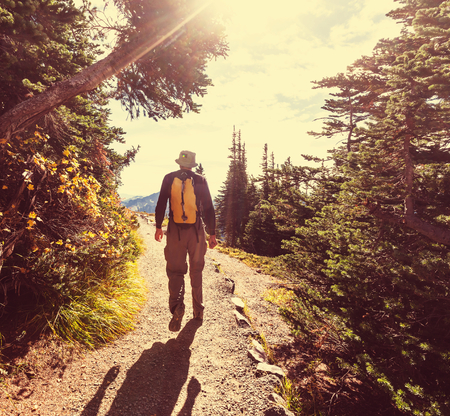1. Why Sunglasses Matter on the Trail
When youre out hiking, sunglasses are more than just a style accessory—theyre essential gear for keeping your eyes safe. Whether youre trekking through a sunny desert, climbing a rocky peak, or walking deep in the woods, eye protection matters in every kind of terrain and weather. Heres why:
Protecting Your Eyes from UV Rays
Exposure to ultraviolet (UV) rays increases with elevation and open landscapes. Without sunglasses, your eyes are at risk for sunburn (yes, it happens!), cataracts, and even long-term vision damage. Snowy trails can double the threat by reflecting sunlight right into your eyes.
UV Exposure Levels by Terrain
| Terrain | UV Exposure Level | Risk Without Sunglasses |
|---|---|---|
| Mountain/High Elevation | Very High | Severe eye damage, snow blindness |
| Desert/Open Fields | High | Sunburned eyes, increased risk of cataracts |
| Forest/Shaded Trails | Moderate | Cumulative UV exposure over time |
| Lakes/Rivers/Waterways | High (due to reflection) | Glare discomfort, increased UV impact |
Shielding Against Debris and Wind
Sunglasses protect your eyes from flying dust, sand, and twigs—especially on windy days or rugged trails. Even a small branch or a gust of wind kicking up dirt can cause irritation or injury if you’re not wearing proper eye protection.
Weather-Related Risks: More Than Just Sunshine
The weather can throw all sorts of challenges at hikers. Snow glare is notorious for causing temporary blindness. On cloudy days, UV rays still penetrate clouds, so skipping sunglasses isn’t safe. Plus, rain or sleet can make it tough to see and make your hike uncomfortable without good eyewear.
Main Trail Risks Sunglasses Can Prevent
| Hazard Type | Description | Sunglasses Protection? |
|---|---|---|
| UV Radiation | Invisible rays that damage eyes over time. | Yes—blocks harmful rays. |
| Debris/Dust/Wind | Irritates or injures unprotected eyes. | Yes—creates a physical barrier. |
| Glare (Snow/Water) | Makes it hard to see; causes discomfort. | Yes—polarized lenses reduce glare. |
| Rain/Sleet/Snowflakes | Makes vision blurry and uncomfortable. | Yes—keeps moisture out of eyes. |
2. Budget Sunglasses: Pros, Cons, and Popular Picks
Why Consider Budget Sunglasses for Hiking?
Not every hiker wants to spend a fortune on sunglasses, especially if you’re just getting started or tend to misplace your gear. Affordable hiking sunglasses can offer solid protection from the sun’s rays without breaking the bank. Let’s break down what you get—and what you might miss—with budget-friendly options.
Pros of Budget Sunglasses
- Wallet-Friendly: These shades are easy on your budget, so it’s no big deal if you lose or scratch them on the trail.
- Variety of Styles: Even affordable brands offer plenty of designs, from sporty wraparounds to classic aviators.
- Basic UV Protection: Many low-cost sunglasses still block 99-100% of UVA/UVB rays—essential for eye safety outdoors.
- Lightweight: Budget sunglasses are often made with lightweight materials, making them comfortable for all-day hikes.
Cons of Budget Sunglasses
- Durability: Cheaper frames and lenses may crack or scratch more easily than premium models.
- Limited Features: You might not find advanced coatings like polarization, anti-fog, or impact resistance in this price range.
- Fit and Comfort: Lower-priced options sometimes lack adjustable nose pads or grippy arms, which can affect stability during rugged hikes.
- Lens Clarity: Visual clarity and color accuracy may not match higher-end models, especially in tricky light conditions.
Top Affordable US Brands for Hikers
If you’re looking for reliable, budget-friendly sunglasses that cater to outdoor enthusiasts, these American brands stand out:
| Brand | Main Features | Approximate Price Range | Popular Models |
|---|---|---|---|
| Goodr | No-slip fit, fun styles, polarized lenses | $25–$35 | The OGs, BFGs |
| Tifosi Optics | Lightweight, shatterproof lenses, sporty look | $25–$50 | Swank, Shwae |
| Sungait | UV400 protection, flexible frames, budget pricing on Amazon | $15–$30 | Sungait Ultra Lightweight Series |
| KastKing | Polarized lenses, impact-resistant frames, designed for active lifestyles | $20–$40 | KastKing Skidaway, Hiwassee |
| Duduma | Affordable sports eyewear, 100% UV protection, lightweight design | $15–$30 | Duduma Polarized Sports Series |
Quick Tips for Choosing Budget Hiking Sunglasses:
- Look for labels that specify 100% UVA/UVB protection—don’t settle for less!
- If you hike near water or snowfields, consider polarized lenses to cut glare.
- A snug fit is key; test out different styles to see which stays put when you move.
- If you wear prescription glasses, check if the brand offers clip-ons or over-glasses designs.
- Read customer reviews from other hikers for real-world feedback before buying.

3. Premium Sunglasses: Worth the Investment?
When you’re hitting the trail, premium sunglasses aren’t just a fashion statement—they’re designed to meet the demanding needs of serious hikers. Let’s dive into what makes high-end sunglasses stand out, especially for those who want maximum eye protection and comfort on their outdoor adventures.
Advanced Lens Technology
Premium sunglasses often feature top-notch lens technology tailored for outdoor use. Here are some key features you’ll find:
| Lens Feature | Description |
|---|---|
| Polarized Lenses | Reduces glare from surfaces like water, rocks, and snow, giving you clearer vision on bright days. |
| Photochromic Lenses | Automatically adjust tint based on sunlight intensity—great for trails that move in and out of shade. |
| UV Protection | Blocks 100% of UVA and UVB rays to protect your eyes from long-term sun damage. |
| Anti-Fog & Hydrophobic Coatings | Keeps your lenses clear during sweaty climbs or sudden weather changes. |
Durability That Lasts
No one wants their gear to fail halfway up a mountain. Premium sunglasses are built with tough materials like polycarbonate or Trivex lenses, and frames made from lightweight, impact-resistant materials (such as Grilamid or titanium). These can handle drops, scrapes, and rough handling way better than most budget options.
Fit and Comfort for Long Hikes
The right fit makes all the difference on long treks. High-end brands pay extra attention to details such as adjustable nose pads, flexible temple arms, and grippy rubber inserts to keep your shades in place—even when you’re sweating or moving fast. Some models even come in different sizes or shapes to match various face types.
Popular American Premium Brands for Hikers
| Brand | What Theyre Known For | Notable Models |
|---|---|---|
| Oakley | Sports-focused design, high-impact resistance, and Prizm lens tech for color contrast. | Flak 2.0 XL, Radar EV Path |
| Smith Optics | ChromaPop lenses enhance clarity; durable frames perfect for backcountry use. | Guide’s Choice, Attack MAG MTB |
| Maui Jim | Pioneers in polarized lens tech; lightweight and comfortable fit ideal for all-day wear. | Pehuea, Ho’okipa Reader |
| Costa Del Mar | Tough frames and 580 lens technology designed for outdoor sports and water activities. | Fantail Pro, Rincon |
Is It Worth Paying More?
If you spend lots of time outdoors or have sensitive eyes, investing in premium sunglasses can really pay off. The advanced features boost eye comfort and safety while lasting through years of rugged use. For casual hikers or those on a tight budget, basic models might do the trick—but for those chasing epic views every weekend, premium eyewear could be your best trail companion.
4. Features to Consider: Making the Right Choice
Lens Material: Durability and Clarity
The type of lens material in your hiking sunglasses can make a big difference in both protection and comfort. Here’s a quick look at the most common options:
| Material | Pros | Cons |
|---|---|---|
| Polycarbonate | Lightweight, impact-resistant, affordable | May scratch more easily, less optical clarity |
| Trivex | Lightweight, great optical clarity, impact-resistant | A bit pricier than polycarbonate |
| Glass | Excellent clarity, scratch-resistant | Heavier, can shatter, more expensive |
Polarization: Reducing Glare on the Trail
If you hike near water, snow, or open rocky terrain, polarized lenses help cut down glare. This means clearer vision and less eye strain, especially during long hikes. Most premium sunglasses offer polarization as a standard feature, while budget options might not.
Frame Comfort: Fit for Every Adventure
You’ll want frames that are lightweight and fit snugly without squeezing your temples or sliding down your nose. Look for these features:
- Nose Pads: Adjustable pads offer a personalized fit and reduce slipping when you sweat.
- Flexible Hinges: These add durability and comfort for all-day wear.
- Wraparound Design: Offers better coverage from sun and wind – a big plus on exposed trails.
Warranty: Peace of Mind on Your Hikes
A good warranty is a sign that the brand stands behind its product. Premium sunglasses usually come with longer warranties covering defects or accidental damage. Budget models may offer limited coverage or none at all. If you’re investing in pricier shades, check the fine print so you know what’s covered if something goes wrong.
Quick Feature Comparison Table
| Feature | Budget Sunglasses | Premium Sunglasses |
|---|---|---|
| Lens Material Options | Mainly polycarbonate | Polycarbonate, Trivex, glass options available |
| Polarization | Sometimes included or optional upgrade | Standard feature in most models |
| Frame Comfort Features | Simpler design, basic fit adjustments | Nose pads, flexible hinges, ergonomic designs common |
| Warranty Coverage | Limited or none | 1 year or lifetime warranties often available |
No matter your budget, knowing what features matter most will help you pick sunglasses that keep your eyes safe and comfortable mile after mile on the trail.
5. Real-Life Scenarios: Budget vs. Premium in the Wild
If you’re wondering how sunglasses really perform out on the trail, let’s look at some real-life stories and situations that US hikers have faced. Whether trekking the Rockies or hiking through the forests of the Pacific Northwest, both budget and premium sunglasses have their moments to shine—or sometimes fail.
Case Study 1: The Appalachian Trail Weekend Warrior
Mike, a casual hiker from Georgia, grabbed a pair of $20 budget sunglasses before a sunny weekend hike on the Appalachian Trail. The shades held up fine against dust and minor bumps but started fogging up during steep climbs. When a sudden rain shower hit, he noticed water spots that wouldn’t wipe off easily, making it tough to see clearly. Still, Mike appreciated that if he lost or broke them, it wouldn’t hurt his wallet.
Case Study 2: Rocky Mountain High with Premium Shades
Sara is an experienced backpacker who invested in $150 polarized sunglasses for her Colorado Rockies trip. With intense sun reflecting off snow patches, her premium lenses kept glare in check and offered crisp vision all day. The anti-fog coating worked well during sweaty uphill sections, and the frames stayed comfortable even under a wide-brimmed hat. While she was nervous about misplacing such an expensive pair, Sara felt her eyes were well-protected.
Quick Comparison: Trail Experiences
| Scenario | Budget Sunglasses | Premium Sunglasses |
|---|---|---|
| Durability after drops | Prone to scratches/cracks | More resistant to impact |
| Clarity in changing light | May struggle with glare or fog | Adaptive lenses reduce strain |
| Comfort for long hikes | Can pinch or slip off | Cushioned fit, secure grip |
| Reaction to sudden weather changes | Lenses can smudge/fog easily | Better coatings for water & fog resistance |
| Pain of loss or breakage | Low-cost to replace | Tough on the budget if lost/damaged |
Anecdote from the Desert Southwest
An Arizona hiker shared how his discount sunglasses failed during a dusty windstorm in Sedona—grit got between the lens and frame, scratching them badly. Meanwhile, his friend with high-end sunglasses had no issues thanks to snug-fitting wraparound frames and scratch-resistant lenses.
The Takeaway from the Trail
No matter where your US hiking adventure takes you—from alpine lakes in Montana to redwood forests in California—both budget and premium sunglasses have strengths and weaknesses depending on conditions. Knowing what features matter most for your favorite trails can help you pick wisely for your next outdoor journey.

